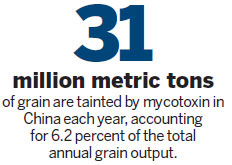Scientists say govt could cut waste by $13.6 billion a year
China must act to combat toxic funguses that destroy grain harvests, and the situation is "an invisible threat" to human health worldwide, experts said.

"Prevention and control of mycotoxins is an urgent need for China and the world in guaranteeing food and environment security," said Chen Mengshan, head of the China Academy of Agricultural Sciences, at the opening ceremony of the International Mycotoxin Conference 2014 in Beijing on Tuesday.
Hosted by the academy's Institute of Agro-products Processing Science and Technology, the conference drew more than 300 officials, scientists and entrepreneurs from 28 countries to share their perspectives on the global prevention and control of mycotoxins. The conference will end on Friday.
With proper prevention and control measures, the country can avert economic losses in mycotoxin-contaminated food and food products, which are up to 85 billion yuan ($13.6 billion) a year, scientists said.
About 31 million metric tons of grain a year - about 6.2 percent of the country's total annual grain output - are tainted by mycotoxins during production, storage and logistics, according to the State Administration of Grain.
Mycotoxins are toxic fungal metabolites produced by molds, which occur frequently in areas with a hot and humid climate that is favorable for the growth of molds. The metabolites can even cause sickness or death in humans or domestic animals when ingested, inhaled or absorbed through the skin.
"It is an invisible threat for agriculture and human health across the world," said Dai Xiaofeng, director of the institute. Dai added that climate change is making an environment more suitable for mycotoxins.
"While China is endeavoring to maintain at least a 1 percent increase in its annual grain output, mycotoxin pollution is creating huge waste of grain and crops," Dai said.
Mycotoxin pollution exists everywhere, from production to storage, and covers a variety of plants, including grain, corn, soybeans and fruit.
The Food and Agriculture Organization has estimated that 25 percent of the world's crops are affected by mycotoxins every year, with annual losses reaching about 1 billion tons of foods and food products.
General interest in mycotoxins rose in 1960 when a feed-related disease caused by aflatoxin, a main kind of mycotoxins, killed hundreds of thousands of turkeys in farms in England. Aflatoxins can cause liver damage and even liver cancer in humans.
In 2004, more than 100 people died in Kenya after they ate aflatoxin-contaminated maize.
Liu Yang, professor from the Department of Food Safety and Quality Control of the Institute of Agro-products Processing Science and Technology, said that in addition to its effect on human health, mycotoxin contamination is one of the main barriers blocking Chinese foods exported to Europe.
Liu said that from 2002 to 2011, nearly 30 percent of the 2,559 rejected export cases from China to the European Union involved an excessive level of mycotoxin.
"Chinese authorities regard mycotoxin prevention and control as a top priority," said Jin Fazhong, deputy director of the agriculture ministry's agro-food safety supervision department.
He said a nationwide biotoxin risk assessment for agricultural products has been launched with research, funded by the government, that started in 2012.
Liu, chief scientist of a national research project on mycotoxin, said his team has developed a control mechanism for mycotoxin prevention and set up a mycotoxin database in the past few years.
Markus Klingler, agricultural counselor of the Delegation of the European Union to China, praised what he called China's "impressive" achievements and suggested enhancing international collaboration in combating mycotoxin.
Contact the writer at wangqian@chinadaily.com.cn
